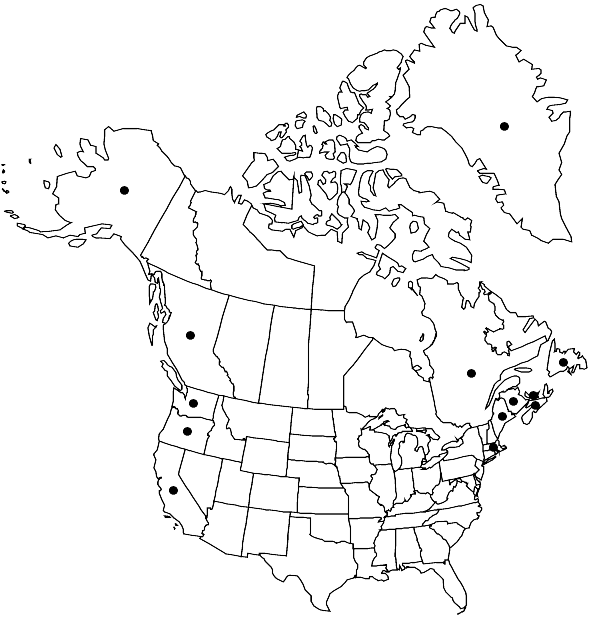Difference between revisions of "Schistidium maritimum"
Bryol. Europ. 3: 102. 1845,.
FNA>Volume Importer |
FNA>Volume Importer |
||
| Line 28: | Line 28: | ||
|elevation=low elevations (0-20 m) | |elevation=low elevations (0-20 m) | ||
|distribution=Greenland;B.C.;N.B.;Nfld. and Labr. (Nfld.);N.S.;P.E.I.;Que.;Alaska;Calif.;Maine;Mass.;Oreg.;Wash.;Eurasia. | |distribution=Greenland;B.C.;N.B.;Nfld. and Labr. (Nfld.);N.S.;P.E.I.;Que.;Alaska;Calif.;Maine;Mass.;Oreg.;Wash.;Eurasia. | ||
| − | |discussion=<p>Schistidium maritimum is one of the easiest species of the genus to identify. Its usually 2-stratose distal laminae, well developed stereid bands, usually small and often campanulate capsules, and coastal habitat are distinctive. Subspecies piliferum, characterized by the presence of awns and a single stereid layer, is not recognized here; further study is needed.</p> | + | |discussion=<p><i>Schistidium maritimum</i> is one of the easiest species of the genus to identify. Its usually 2-stratose distal laminae, well developed stereid bands, usually small and often campanulate capsules, and coastal habitat are distinctive. Subspecies piliferum, characterized by the presence of awns and a single stereid layer, is not recognized here; further study is needed.</p> |
|tables= | |tables= | ||
|references= | |references= | ||
| Line 52: | Line 52: | ||
|publication year= | |publication year= | ||
|special status= | |special status= | ||
| − | |source xml=https://jpend@bitbucket.org/aafc-mbb/fna-data-curation.git/src/ | + | |source xml=https://jpend@bitbucket.org/aafc-mbb/fna-data-curation.git/src/8f726806613d60c220dc4493de13607dd3150896/coarse_grained_fna_xml/V27/V27_300.xml |
|subfamily=Grimmiaceae subfam. Grimmioideae | |subfamily=Grimmiaceae subfam. Grimmioideae | ||
|genus=Schistidium | |genus=Schistidium | ||
Revision as of 16:54, 18 September 2019
Plants in tufts, olivaceous, often brownish. Stems 0.8–5 cm, central strand absent. Leaves usually curved, sometimes erect, often somewhat contorted when dry, ovate-lanceolate to linear-lanceolate, keeled, (1.2–)1.5–2.6(–4) mm, usually 2-stratose distally; margins usually plane distally, recurved proximally, smooth or papillose, 2-stratose or 3-stratose, rarely 4-stratose distally; apices acute or blunt, sometimes ending in a short, fleshy, multistratose apiculus; costa percurrent, rarely excurrent as a short denticulate awn, with guide cells and one or two stereid bands, abaxial surface usually slightly papillose; basal marginal cells quadrate or short-rectangular, often trigonous; distal laminal cells isodiametric, rounded or angular, sometimes short-rectangular, 7–11 µm wide, smooth or weakly papillose, sometimes weakly bulging-mammillose, straight or slightly sinuose. Sexual condition autoicous. Capsule dark reddish brown or dark brown, ovoid, cupulate, or campanulate, 0.6–1.3 mm; exothecial cells usually angular, isodiametric, occasionally elongate, thick-walled; stomata present; peristome patent to revolute, 200–500 µm, red, papillose, often strongly perforated. Spores 15–30 µm, granulose.
Phenology: Capsules mature late spring to early summer.
Habitat: Rocks within or near the spray zone along coasts
Elevation: low elevations (0-20 m)
Distribution

Greenland, B.C., N.B., Nfld. and Labr. (Nfld.), N.S., P.E.I., Que., Alaska, Calif., Maine, Mass., Oreg., Wash., Eurasia.
Discussion
Schistidium maritimum is one of the easiest species of the genus to identify. Its usually 2-stratose distal laminae, well developed stereid bands, usually small and often campanulate capsules, and coastal habitat are distinctive. Subspecies piliferum, characterized by the presence of awns and a single stereid layer, is not recognized here; further study is needed.
Selected References
None.